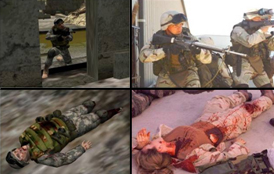DARPA DARWARS Student State Assessment
 |
The goal of the Phase II project was to examine effectiveness of virtual reality training simulators’ ability to teach tactical and trauma care skills, practice stress management techniques (e.g., combat breathing), and improve performance during real-life combat situations.
Test group participants trained in a virtual combat scenario while their stress and arousal levels were monitored through non-invasive physiological means. Control group participants did not receive virtual training. Subsequently, all participants were tested in a real-world version of this same combat scenario to determine the effectiveness of training in a virtual environment.
Significant transfer of skills from virtual training to real-world exercises has been demonstrated in experiments with the U.S. Army, Navy SEALs and Corpsmen, Marine Corps, Coast Guard, and Drug Enforcement Agency personnel. Repeated exposure to stressful stimuli, combined with immediate physiological feedback, provides the tools for helping law enforcement personnel achieve peak performance. In addition to providing state-of-the-art training for military law enforcement and first responders, other uses include trauma care training for the civilian population and scenarios for mental health care delivery.
The Phase III product will consist of a non-invasive vital sign monitor to detect student state, a service to create a video game that is a representation of any real-world training scenario, and a site in which real-world training can take place in a realistic setting.
This VRMC work has resulted in recognition as Best in Show, Poster Presentation, “Beyond Phase II: Ready for Transition,” National SBIR Phase II Conference 2005, San Diego, CA, and as a 2005 Nominee, Small Business Achievement Award, DARPA.
VRMC is a member of the National Center for Simulation, and VRMC’s Executive Director is a member of the NATO Modeling and Simulation Group Task Group MSG-051, which recommends standards in this area for all NATO countries.
![]()
